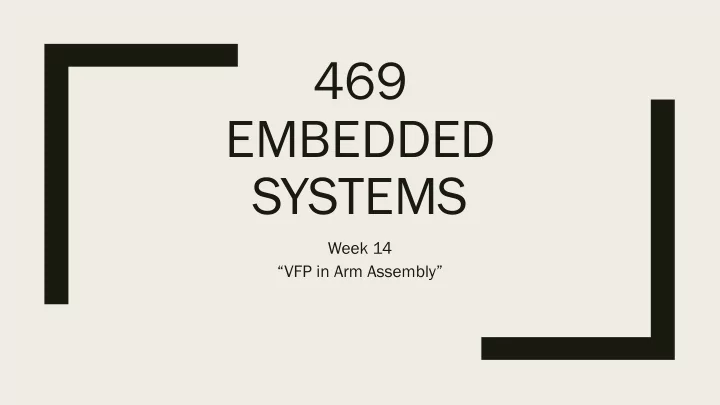

469 EMBEDDED SYSTEMS Week 14 “ VFP in Arm Assembly ”
FPU usage in C ■ Your C codes automatically use the FPU. Because you compilers are designed for it. ■ So in Keil – If you compile for a system with a hardware VFP (Vector Floating Point) coprocessor (in other words an FPU, like in our TM4C123G), ■ the ARM compiler makes use of the FPU. – If you compile for a system without a coprocessor, the compiler implements the computations in software. ■ So Keil handles everything for us.
FPU usage in Keil ■ Please visit FP support page
FPU usage in Assembly ■ In order to use the FPU in assembly, you will have to do it yourselves. No compiler is here to help you. – First you enable it – Then use the necessary FPU assembly instructions
Enabling the FPU ■ The FPU is disabled from reset. ■ You must enable it before you can use any floating-point instructions. ■ The processor can read from and write to the Coprocessor Access Control (CPAC) register. – The below example code sequence enables the FPU:
Coprocessor Access Control (CPAC) Register (p.195)
M4 FPU Assembly Instructions ■ Please check the Arm Cortex M3/M4 instruction set. ■ On Page 159, you will find the FPU assembly instructions table:
FPU Instruction durations https://developer.arm.com/docs/ddi0439/b/floating-point-unit/fpu-functional-description/fpu-instruction-set
FPU Instruction durations
ARM M4 FPU Registers ■ The FPU provides an extension register file containing 32 single-precision registers. These can be viewed as: ■ Sixteen 64-bit doubleword registers, D0-D15 ■ Thirty-two 32-bit single-word registers, S0-S31 ■ A combination of registers from the above views
How to use them ■ Same as fixed-point instructions http://infocenter.arm.com/help/index.jsp?topic=/com.arm.doc.dui0802a/Bcfchhif.html
Recommend
More recommend